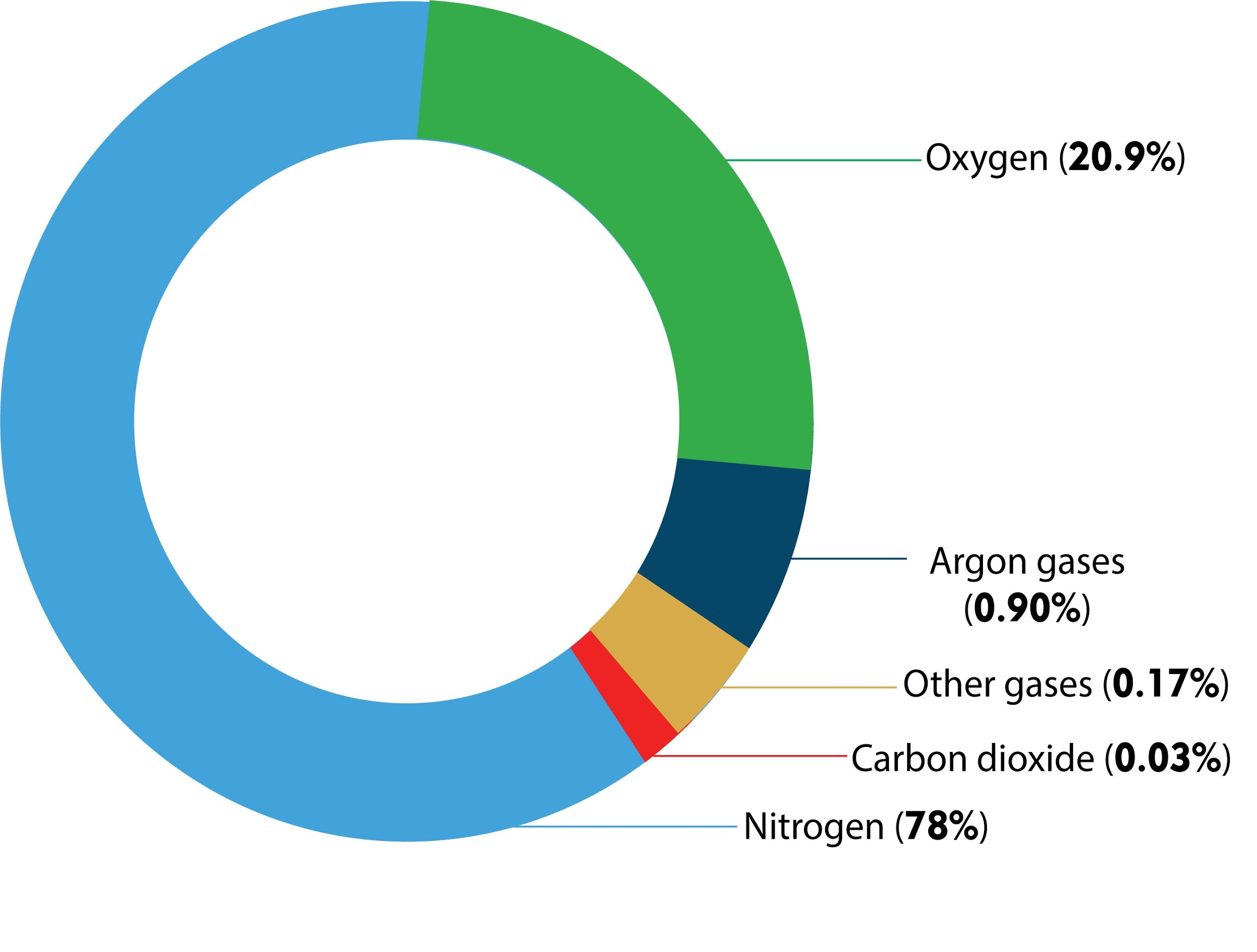Percent Of Air That Is Oxygen

The air we breathe is a complex mixture of gases, and among them, oxygen plays a pivotal role in sustaining life on Earth. Understanding the composition of the Earth’s atmosphere and the percentage of oxygen within it is crucial for comprehending the delicate balance that supports life. In this article, we delve into the fascinating world of atmospheric composition, exploring the origins, significance, and the percentage of oxygen that makes our planet habitable.
Earth’s Atmosphere:
Earth’s atmosphere is a dynamic envelope of gases that surrounds the planet, extending hundreds of kilometers above the surface. This gaseous layer is crucial for various reasons, including regulating temperature, protecting against harmful solar radiation, and providing the necessary elements for life. The composition of the atmosphere has evolved over billions of years, shaped by geological and biological processes.
The Primordial Atmosphere:
During the early stages of Earth’s formation, the atmosphere was vastly different from what we breathe today. The primordial atmosphere likely consisted of gases such as methane, ammonia, water vapor, and carbon dioxide, devoid of the life-sustaining oxygen we depend on. These gases were released during volcanic activity and other geological processes, creating an atmosphere that would be inhospitable to most modern life forms.
The Rise of Oxygen:
The transformation of Earth’s atmosphere into one capable of supporting aerobic life is attributed to the emergence of photosynthetic organisms, particularly cyanobacteria. These microorganisms, also known as blue-green algae, appeared around 3.5 billion years ago and began the process of photosynthesis, converting sunlight into energy and releasing oxygen as a byproduct. This marked the beginning of the oxygenation of Earth’s atmosphere.
Oxygen Percentage in Earth’s Atmosphere:
While oxygen is crucial for supporting life, it only constitutes a relatively small fraction of Earth’s atmosphere. The Earth’s atmosphere is primarily composed of nitrogen, which makes up about 78% of the total volume. Oxygen, on the other hand, accounts for approximately 21% of the atmosphere. The remaining 1% consists of trace gases, including argon, carbon dioxide, neon, helium, and other elements.
The significance of the 21% oxygen in the atmosphere lies in its essential role in cellular respiration. Oxygen is a key component in the process of extracting energy from food molecules, allowing organisms to thrive and function. This process is fundamental for the metabolic activities of most aerobic organisms, including humans.
Oxygen Variations:
While the overall percentage of oxygen in Earth’s atmosphere remains relatively stable, there can be slight variations due to various factors. Geographic location, altitude, and even human activities can influence local concentrations of oxygen. For instance, at higher altitudes, where atmospheric pressure is lower, the percentage of oxygen remains constant, but the partial pressure decreases, affecting the availability of oxygen for breathing.
Human Impact on Oxygen Levels:
Human activities, particularly industrial processes and deforestation, have the potential to impact the delicate balance of Earth’s atmosphere. The combustion of fossil fuels releases carbon dioxide into the atmosphere, contributing to the greenhouse effect and climate change. While this does not directly affect the percentage of oxygen, it underscores the interconnected nature of Earth’s systems and the importance of maintaining a stable atmosphere for life.
Breathing and Oxygen Uptake:
Breathing, the process by which organisms take in oxygen and expel carbon dioxide, is a fundamental aspect of life. In humans and many other animals, the respiratory system facilitates the exchange of gases between the lungs and the bloodstream. Oxygen from the air is transported by red blood cells to tissues and organs, where it is utilized in cellular respiration.
The human respiratory system is finely tuned to extract oxygen efficiently from the air we breathe. The concentration of oxygen inhaled is relatively constant at around 21%, but the respiratory system can adapt to changes in environmental conditions to ensure a consistent supply of oxygen to the body.
Oxygen and Evolution:
The availability of oxygen in Earth’s atmosphere has had a profound impact on the evolution of life. The rise of aerobic organisms, which can harness oxygen for energy production, led to the development of more complex and energy-efficient life forms. The evolution of multicellular organisms and, eventually, complex life forms like animals and plants is intricately tied to the presence of oxygen in the atmosphere.
Oxygen as a Double-Edged Sword:
While oxygen is essential for life, it can also have detrimental effects in certain circumstances. Reactive oxygen species (ROS), which are highly reactive molecules containing oxygen, can cause damage to cells and tissues. The human body has developed mechanisms to neutralize these reactive species, but an imbalance can lead to oxidative stress and various health issues.
Medical Applications of Oxygen:
Oxygen has significant applications in the field of medicine. Oxygen therapy is commonly used to treat respiratory conditions such as chronic obstructive pulmonary disease (COPD), pneumonia, and respiratory failure. The administration of supplemental oxygen can enhance the oxygen supply to tissues and improve overall respiratory function.
Conclusion:
The percentage of oxygen in Earth’s atmosphere, though seemingly small at 21%, plays a pivotal role in the sustenance of life. From the evolution of aerobic organisms to the intricate respiratory processes in humans, oxygen is a fundamental element that has shaped the course of life on our planet. As we continue to explore and understand the complexities of Earth’s atmosphere, it becomes evident that the delicate balance of gases, particularly the presence of oxygen, is essential for the thriving biodiversity that makes our planet unique. It is our responsibility to preserve this balance and ensure the continued habitability of our home, Earth.
